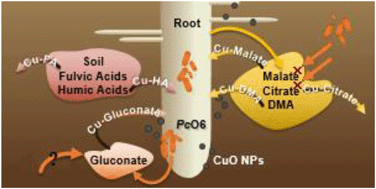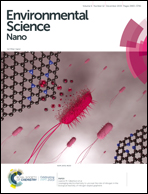Soil-derived fulvic acid and root exudates, modified by soil bacteria, alter CuO nanoparticle-induced root stunting of wheat via Cu complexation†
Abstract
CuO nanoparticles (NPs) are explored as fungicides and fertilizers, and are increasingly likely to be applied to agricultural soils. Consequently, interactions of CuO NPs with soil pore water (SPW) components, plants, and microbes must be understood. These experiments examined whether dissolved natural organic matter (DNOM) from SPW, or root/bacterial exudates, changed wheat (Triticum aestivum L. v. Deloris) responses to 100 mg kg−1 (Cu/sand) as CuO NPs. Seedlings were grown in sand with 3.34 mM Ca(NO3)2 or one of three SPWs, differing in DNOM concentration and composition. At 10 days post-germination, CuO NPs stunted roots by 59% in the 3.34 mM Ca(NO3)2 and 26–35% in the three SPWs compared to plants grown without NPs. Malate, citrate, gluconate, and 2′-deoxymugineic acid (DMA), were elevated 1.3 to 5-fold in the rhizosphere with CuO NPs present. Cu was bioavailable through metallo-organic complexes, including Cu–DMA and Cu–gluconate. Fulvic acid in SPWs mitigated CuO NP-induced wheat root shortening. Pseudomonas chlororaphis O6 eliminated malate and citrate in the rhizospheres, reduced rhizosphere dissolved Cu ∼18–66%, and reduced root Cu 39% across all SPWs while enhancing root stunting ∼17% more across all SPWs than non-inoculated wheat grown with CuO NPs. Thus, both SPW components and root microbial colonization influenced wheat responses to CuO NPs. These interactions are likely in agricultural soils with additional processes, such as ion sorption, to influence CuO NP phytotoxicity, highlighting the importance of considering not just the target plant, but soil properties and associated microbiomes when evaluating impacts of NPs in agricultural usage.



 Please wait while we load your content...
Please wait while we load your content...
